The July 2016 unemployment report shows a pretty good month of statistics. The unemployment rate remained the same at 4.9%. Yet this month, unlike others, the low unemployment rate is not due to more people dropping off of the statistical radar. Instead the labor participation rate ticked up a tenth of a percentage point as more people entered the labor force. Another piece of promise is the number of people who entered the labor force almost equaled those newly employed. One month does not a pattern make, especially with BLS statistics, yet seeing less people dropping out of the labor force is a welcome change.
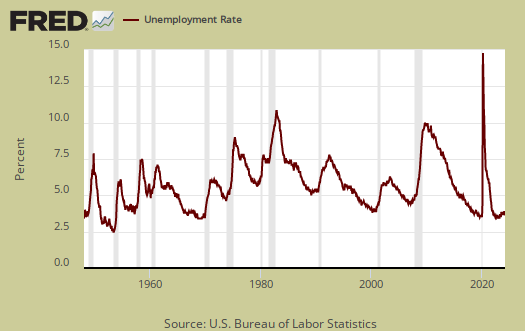
This article overviews and graphs the statistics from the Employment report Household Survey also known as CPS, or current population survey. The CPS survey tells us about people employed, not employed, looking for work and not counted at all. The household survey has large swings on a monthly basis as well as a large margin of sampling error. This part of the employment report is not about actual jobs gained but people and their labor status.
Those employed now stands at 151,517,000, a monthly increase of 420 thousand. From a year ago, the ranks of the employed has increased by 2.172 million. That's a huge monthly gain and more in line with the monthly gains earlier in the year.
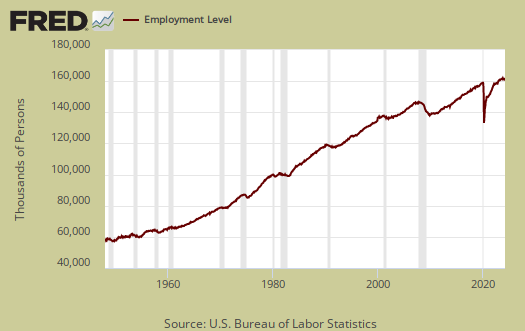
Those unemployed number 7,770,000, a monthly -13,000 decline. From a year ago the unemployed has decreased by -479,000. That the status quo on this figure hasn't changed much isn't surprising since the real unemployment problem is with those no longer counted.
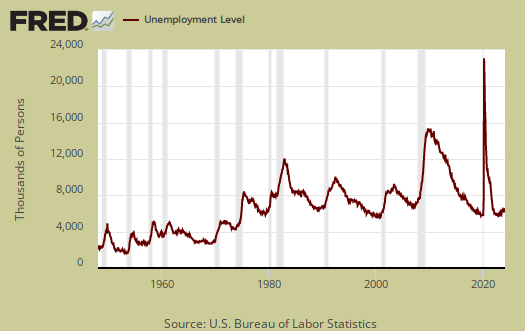
Those not in the labor force is 94.333 million. The below graph are the not in the labor force ranks. Those not in the labor force has increased by 572,000 in the past year, which pundits like to blame on baby boomers but we know better. It is people who need a job who have stopped trying to get one in addition to retirees.
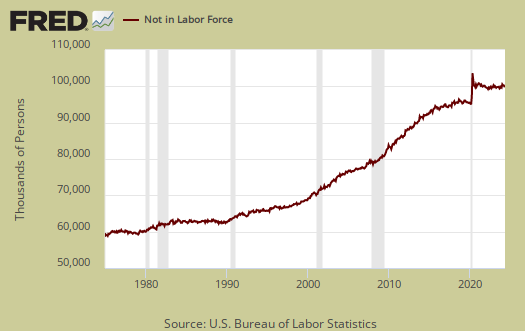
The labor participation rate is 62.8%. This is a 0.1 percentage point increase from last month. Pre-recession, the January 2008 labor participate rate was 66.2% a far cry from what we see today. Ignoring labor participation rates after 2008, one has to go to the late 1977 to find rates this low. We consider this the most telling on where those people swept under the labor rug have really gotten too.
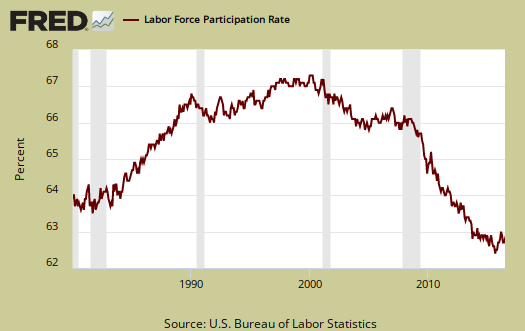
Below is a graph of the labor participation rate for those between the ages of 25 to 54. The rate is 81.2% and had no change from the June. These are the prime working years where people are not in retirement or in school full time commonly, so one should not see record low participation rates. In January 2008 the prime working years labor participate rate was 83.3%.
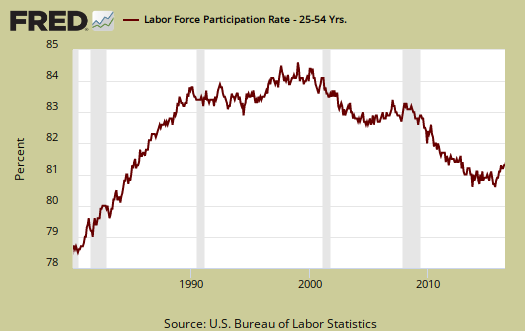
The civilian labor force, which consists of the employed and the officially unemployed, increased by 407,000 to stand at 159,287,000. The civilian labor force has grown by 2,744,000 over the past year. This is actually high annual growth, we hope it stays that way because those long cast aside are finally becoming employed again. We hope it is not artificial growth since the BLS counts those on guest worker Visas and even illegal workers mixed in with permanent resident and citizen workers.
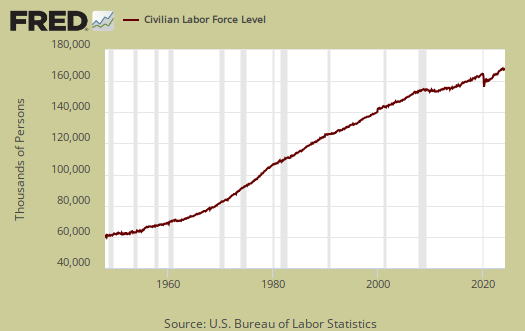
Below is a graph of those not in the labor force, (maroon, scale on the left), against the noninstitutional civilian population (blue, scale on the right). Notice how those not in the labor force crisscrosses the noninstitutional civilian population in growth. The civilian noninstituitonal population is from where all other labor statistics have sprung, so to see strong acceleration in those not counted as participating in the labor force than the pool of population possible to be part of the labor force in the first place has been the bad sign of the last eight years.

Below is a graph of the civilian labor force, or the official employed plus unemployed, in maroon, scale on left, against those not in the labor force, in blue, scale on right. See how those not in the labor force as a trend exceeded those considered employed and unemployed starting around mid 2009. Starting in 2014 it has reverted back, yet it oscillates starting in 2015. To have a solid employment situation those not in the labor force should be growing less than those obtaining jobs and being counted as looking for work. Those not in the labor force does include retirees and students and there is a baby bump with both of these segments of the population.
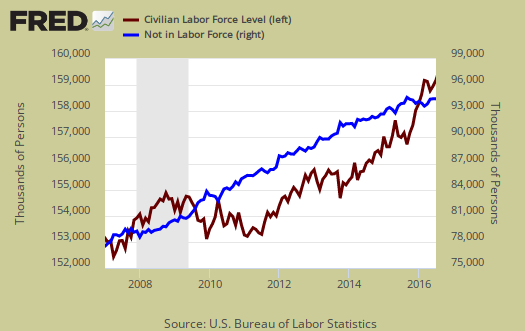
Those considered employed as a ratio to the total Civilian noninstitutional population now stands at 59.7%. Although this is a 0.1 percent increase from last month the level has not seen since 1985 (ignoring the financial crisis aftermath). In January 2008, this figure was 62.9%. We should also point out that the employment to population ratio and the labor participation rate have been oscillating also around record lows in what seems to be an infinity pattern (sic). The relationship between the employment-population ratio and the labor participation rate (LPR) is: employment-population ratio = LPR * (1 - unemployment rate).
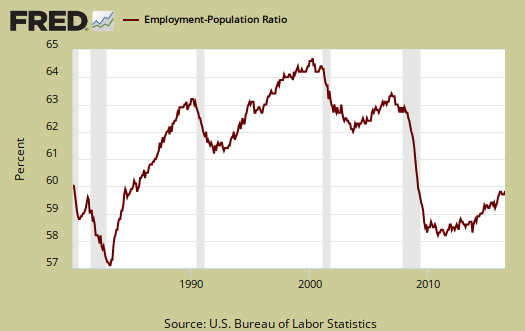
Then there are crappy jobs. and part time work gives us some hints. Those forced into part time work for economic reasons stands at 5,940,000 people. This is a change of 97,000 from last month. The annual decrease of -360 thousand. So, kind of ho hum on the force part time job front for this month.
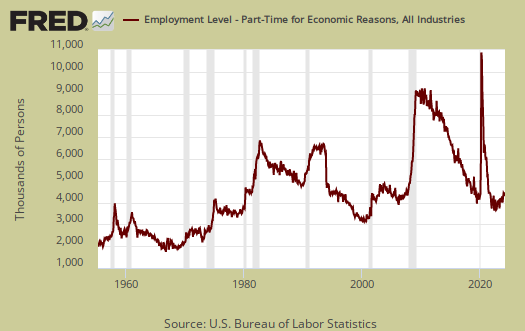
There are two categories of those forced into part-time jobs due to economic circumstances. Those who could only get part-time jobs and those already working who got their hours cut due to businesses not having enough work for them. The number of people who could only get part-time jobs stands at 1,981,000 as shown below. This is a monthly decline of -81 thousand for the month. A year ago, the number of those stuck in part-time jobs was 2,212,000.

People can also work part-time hours due to slack business demand. People who got their hours cut due to slack working conditions stands at 3,642,000, a 199,000 increase from last month and not a good sign. &nbs;Yet this is more what would be expected considering the bad manufacturing statistics and weak GDP report of recent. Below is a graph of forced into part-time work because they got their hours cut, as a percentage of the total employed. This is a recession economic indicator as weak economic demand forces businesses to reduce the working hours of employees.
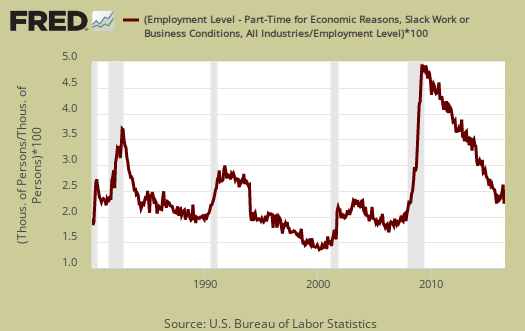
Part-time workers who are voluntarily working part-time jobs stands at 20,717,000, a monthly increase of 212,000. A year ago those working part-time numbered 19,863,000. Tell us this isn't an indicator that people have accepted being marginalized as disposable worker people.

U-6 still stands at 9.7%, which is 0.1 percentage point increase from last month. U-6 is a broader measure of unemployment and includes the official unemployed, people working part-time hours because that's all they can get and a subgroup not counted in the labor force but are available for work and looked in the last 12 months. The U-6 rate still leaves out some people wanting a job who are not considered part of the labor force, so while it is called an alternative rate, but it still ignores many who should be counted as unemployed.
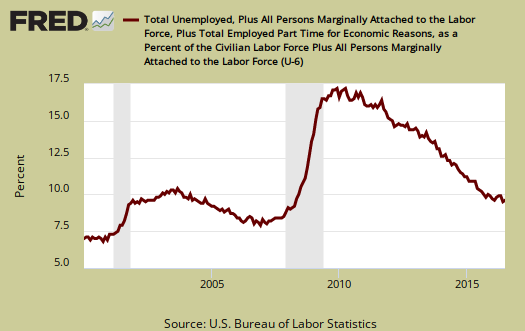
The newly unemployed stands at 2160,000, a -258 thousand monthly decrease. This means less people became newly unemployed, which normally would be a good thing. Statistically speaking, BLS CPS data series are independently calculated, hence one cannot conclude what happened here, except to wait for a few months to see if there is a trend. Below is a graph of those unemployed for less than five weeks.
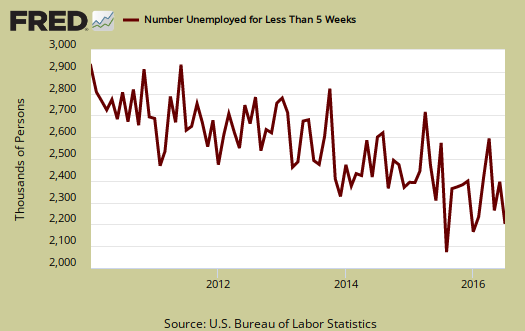
The long term unemployed, or those unemployed for 27 weeks and over, is 2,020,000 people. This is a 41 thousand monthly increase, which is basically monthly statistical noise. From a year ago the long term unemployed ranks has declined by -170,000 which implies the figure has budged (-7.8%), but not enough really.
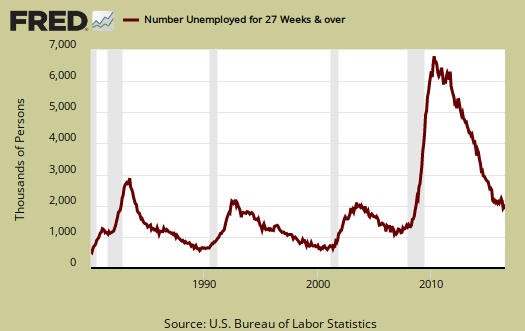
Within the CPS survey is how many people who are considered not in the labor force who report they want a job now. It is a direct survey question. The Census asks people who are not being counted in the unemployment statistics and official unemployment rate if they want a job. The number who answer yes currently stands at 5,886,000. Those not in the labor force who report they want a job declined by -218 thousand from a year ago. For the month those not considered part of the labor force who said they wanted a job increased by 194 thousand. This is another horrific sign for that is a monthly increase of 3.4% Those who are not counted yet report they want a job includes the discouraged workers and marginally attached and is seasonally adjusted.

The average length of unemployment is 28.1 weeks, an increase of 0.4 weeks from last month. The average time to be unemployed has stayed completely out of alignment with the median duration. A year ago the average duration of unemployment was 28.3 weeks so really no change at all from a year ago.

The median time one is unemployed, which means 50% of people have gotten a job in this amount of time is 11.6 weeks, a change of 1.3 weeks from last month. A year ago the median time to be unemployed was 11.4 weeks, a very wicked sign if it holds in next month's release.

This month's CPS report by itself has some good signs. Yet we've seen that before and as the unemployment rate goes lower and lower, more and more people are simply left behind and under the labor rug anyway. Probably the best news of this report is how wages increased 8¢ for all employees and for the year increased 2.6%. Seeing some movement on wages will finally extol the claim America is at full employment. Please remember the usual caveat of the CPS being notoriously volatile with 100,000 data size swings routine from month to month. Here are our past overviews CPS unemployment statistics, only graphs revised.

Recent comments